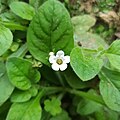| Nama | |
|---|---|
 | |
| Nama demissum, Nevada desert | |
| Scientific classification | |
| Kingdom: | Plantae |
| Clade: | Tracheophytes |
| Clade: | Angiosperms |
| Clade: | Eudicots |
| Clade: | Asterids |
| Order: | Boraginales |
| Family: | Namaceae |
| Genus: | Nama L. [1] |
| Type species | |
| Nama jamaicense L. | |
| Species | |
See text. | |
| Synonyms | |
| |
Nama is a genus of herbaceous plants belonging to the family Namaceae. [2] Most are found in western North America. Many are known by the common name fiddleleaf. [3]




